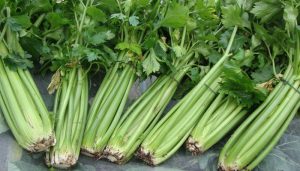 Celery is a member of the umbelliferous family, along with carrots, parsley and fennel. The celery we see today originated from wild celery native to the Mediterranean, where its seeds were once highly valued as a medicine. As with many other folk remedies, modern research is upholding the medicinal value of this common vegetable. In particular, scientists are evaluating the most powerful healing factor of celery—a compound known as 3-nbutylphthalide, or 3nB.
Celery is a member of the umbelliferous family, along with carrots, parsley and fennel. The celery we see today originated from wild celery native to the Mediterranean, where its seeds were once highly valued as a medicine. As with many other folk remedies, modern research is upholding the medicinal value of this common vegetable. In particular, scientists are evaluating the most powerful healing factor of celery—a compound known as 3-nbutylphthalide, or 3nB.
WHAT IS 3NB?
3nB is unique to celery and is responsible for the vegetable’s characteristic flavor and odor. It was discovered as the active component of celery by researchers who were seeking to explain some of the vegetable’s medicinal effects. 3nB first drew significant scientific attention when researchers at the University of Chicago Medical Center identified it as the component responsible for celery’s blood pressure–lowering effect.
The research was prompted by one of the researcher’s fathers who, after eating a quarter-pound of celery every day for a week, observed his blood pressure dropped from 158 over 96 to a normal reading of 118 over 82. Subsequent animal studies found that a very small amount of 3nB lowered blood pressure by 12 to 14 percent, and also reduced cholesterol by about 7 percent.
HOW DOES 3NB LOWER BLOOD PRESSURE?
The blood pressure–lowering effect of 3nB appears to be a result of several factors.
Blood pressure refers to the force with which your blood flows through your vessels. High blood pressure is usually the result of too much fluid in your blood and inflexible or resistant blood vessels. Sodium (salt) retention leads to increased fluid volume in the blood, while hardening of the arteries and the hormones released during stress lead to loss of flexibility or constriction of blood vessels. If you put your thumb over a garden hose, the pressure against your thumb and the resultant pressure of the flow of water out of the hose can be reduced by either turning down the faucet (reducing the fluid volume) or by letting more water flow out of the hose (dilating the vessel).
To treat high blood pressure, doctors usually prescribe diuretics (water pills) to reduce the fluid volume; and vasodilators to relax the arteries to reduce the resistance of blood flow, or beta-blockers to turn down the pumping action of the heart. 3nB appears to help lower blood pressure by acting both as a diuretic and vasodilator, as well as working in a manner similar to drugs known as calcium-channel blockers. 3nB has also been shown in animal and test-tube studies to lower cholesterol levels and reduce the formation of arterial plaque. This effect may increase the elasticity of the blood vessels and thus lead to lower blood pressure readings. In addition, 3nB appears to have some effect on areas and systems of the brain that control vascular resistance.
The benefit of 3nB in treating high blood pressure is its apparent safety and the fact that it has a very unusual mechanism of action as a diuretic. Most diuretics change the ratio of sodium to potassium in the blood and as a result, dangerous side effects can occur due to either too much potassium or sodium. In contrast, 3nB acts as a diuretic but does not alter the ratio of sodium to potassium in the blood.
Research on the blood pressure–lowering effect of celery and celery seed extracts is quite preliminary, but I think it is certainly worth giving them a try, as some people have noted significant reductions in their blood pressure. What research will probably show is that some people with high blood pressure will respond to celery seed extract while others will not. This occurrence is not unusual—physicians will tell you there is a similar phenomenon with conventional drugs used in high blood pressure.
Another real advantage of celery seed extract over conventional drugs used in high blood pressure is that the drugs lower blood flow to the brain. While this effect is helpful in reducing the likelihood of stroke, it often makes people feel tired, depressed, dizzy and forgetful. Celery seed extract, on the other hand, has been shown in animal studies to not only help prevent stroke, but also to improve blood flow and protect the brain and enhance brain energy production in a manner similar to Ginkgo biloba extract. Celery seed extract has also produced dramatic recovery in neurological and brain function in animals in studies that simulate a stroke. In addition, it has been shown to significantly increase life spans in animals.
WHAT OTHER EFFECTS HAVE BEEN NOTED WITH 3NB?
3nB has shown tremendous promise in animal studies as an anticancer phytonutrient and detoxification aid, but its use as a pain reliever in arthritis, fibromyalgia and gout is getting most of the attention.
A celery seed extract standardized to contain 85 percent 3nB has been evaluated in the treatment of rheumatism—the general term used for arthritic and muscular aches and pain. In this study, 3nB’s efficacy was evaluated by well-established clinical protocols used to measure the effectiveness of conventional drugs used in arthritis and muscular pain. These protocols allow objective measures of clinical pain that can be assessed statistically and for individual comparisons. Due to the chronic, fluctuating nature of rheumatism, the study compared results with and without 3nB supplementation.
During the 12-week study, 15 subjects suffering from either osteoarthritis, osteoporosis or gout received 34 mg of the celery seed extract twice daily. Each subject’s pain had been present for approximately 10 years in a remittent or continual form, and it led to a lack of joint mobility and pain that prevented the carrying out of household duties, hobbies and other activities.
 The results of the study were extremely positive and quite statistically significant. The chance that these results were due to a placebo effect is less than one in 1000. After three weeks of taking the celery seed extract, the average reduction in subjects’ pain scores was 68 percent, with some subjects experiencing 100 percent relief from pain. Most subjects achieved maximum benefit after six weeks of use, although some did notice improvements the longer the extract was used. Detailed blood chemistry as well as clinical evaluation of the subjects did not turn up any side effects. Many subjects noticed the celery seed extract produced a diuretic effect, but no changes were noted in their sodium and potassium balances.
The results of the study were extremely positive and quite statistically significant. The chance that these results were due to a placebo effect is less than one in 1000. After three weeks of taking the celery seed extract, the average reduction in subjects’ pain scores was 68 percent, with some subjects experiencing 100 percent relief from pain. Most subjects achieved maximum benefit after six weeks of use, although some did notice improvements the longer the extract was used. Detailed blood chemistry as well as clinical evaluation of the subjects did not turn up any side effects. Many subjects noticed the celery seed extract produced a diuretic effect, but no changes were noted in their sodium and potassium balances.
Based on the positive results in this small pilot study, a larger 70-patient study was conducted. Subjects received 75 mg of the celery seed extract twice daily for three weeks. At this higher dosage, subjects reported even better results than in the pilot study. Statistically and clinically significant reductions were noted in pain scores, mobility and quality of life. Again, no side effects were noted other than the diuretic effect with no changes in the sodium and potassium balance. The celery seed extract appeared to be particularly helpful for sufferers of gout, as 3nB appears to lower the production of the uric acid that causes gout by inhibiting the enzyme xanthine oxidase.
WHAT IS THE PROPER DOSAGE?
More than 100,000 people in Australia have now used this proprietary celery seed extract standardized at 85 percent 3nB without any reports of side effects. The current dosage recommendations, based on the information available from trials as well as clinical experience, are:
For the relief of joint and muscle pain (including pain due to osteoarthritis, rheumatoid arthritis and fibromyalgia): One tablet two to three times daily.
For gout: Two tablets twice daily. NOTE: Initial blood uric acid measurements may increase in people with gout as uric acid crystals begin to dissolve.
Study results indicate that as long as the celery seed extract is used, it keeps pain at bay. But if it is stopped, the pain tends to recur.
